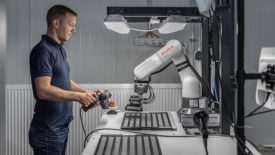Home » Keywords: » cobots
Items Tagged with 'cobots'
ARTICLES
Case Study
Creative Cobot Use Simplifies Product Testing
As the technology has progressed, many companies have discovered ways to reap the benefits of modern cobots beyond manufacturing and assembly operations.
June 25, 2024
Case Study
Remote Robot Monitoring & Control Slashes Downtime Costs
A new approach to remote robot monitoring and error recovery helps companies restart production faster in cases of unplanned robot downtime.
June 20, 2024
Vision & Sensors | Automation
Augmenting Your Workforce: Three Opportunities to Leverage Technology to Automate Repetitive Tasks
As with any good engineering approach to problem-solving, we can divide the manufacturing labor challenge into parts.
June 17, 2024
Quality Headline
Cobot Systems Announces UR+ Partnership with Laser Welding Cobot System
May 25, 2024
Quality in Automation | Robotics
Advanced Automation Delivers the Ultimate in Quality Control
When considering the type of robot for automating inspection tasks, cobots are often the initial go-to solution.
March 29, 2024
Quality in Automation | Case Study
How to Specify Vision Systems when Automating Measurement and Inspection Processes
Perhaps you already know you want to procure a vision system but are wondering how to go about specifying the system.
March 29, 2024
Vision & Sensors | Machine Vision 101
A Quick Guide to Choosing Machine Vision for Collaborative Applications
What are the main considerations to keep in mind?
December 27, 2023
EVENTS
Webinar
7/27/23 to 7/27/24
Contact: Meg M.
Why Cobots Are the First Choice for Many Small to Medium-Sized Companies
Stay in the know with Quality’s comprehensive coverage of
the manufacturing and metrology industries.
eNewsletter | Website | eMagazine
JOIN TODAY!Copyright ©2024. All Rights Reserved BNP Media.
Design, CMS, Hosting & Web Development :: ePublishing






.jpg?height=168&t=1711968358&width=275)


